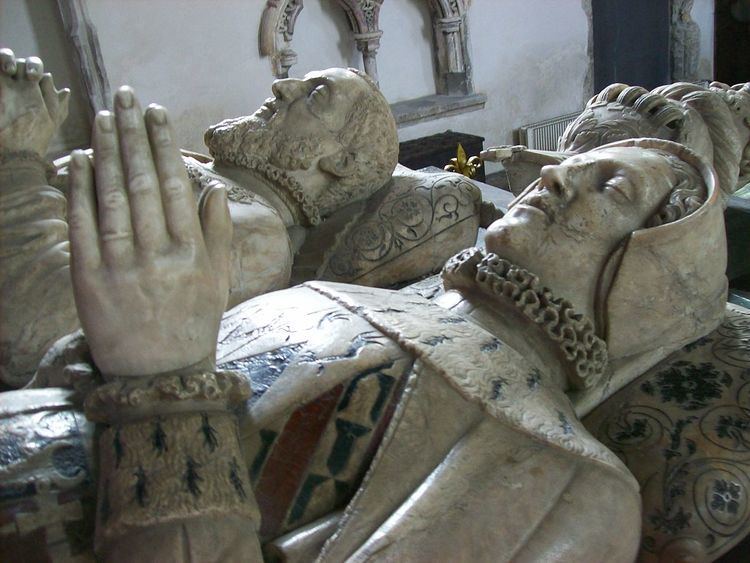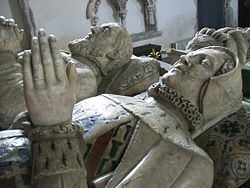Mother Jane Halliwell Died November 1, 1558 | Name Anne Baroness | |
 | ||
Parents Edmund Braye, 1st Baron Braye Children William Brooke, 10th Baron Cobham, Elisabeth Parr, Marchioness of Northampton Grandchildren Maximilian Brooke, Elizabeth Brooke, Margaret Brooke, Sir William Brooke, Frances Brooke Great grandchildren William Cecil, 2nd Earl of Salisbury, Frances Sondes, Frances More | ||
Anne Brooke, Baroness Cobham, born Anne Braye (21 March 1501 – 1 November 1558), was the wife of Sir George Brooke, 9th Baron Cobham. She was the attendant horsewoman at Anne Boleyn's coronation as Queen Consort on 1 June 1533, and she was allegedly one of the first accusers of Queen Anne in 1536. Anne Braye was Baroness Cobham from 1529 until her death in 1558.
Contents
Marriage and issue

Anne Braye was born on 21 March 1501 in Eaton Bray, Bedfordshire, England, the eldest daughter of Sir Edmund Braye (circa 1480 – 18 October 1539), who would be created 1st Baron Braye on 4 December 1529 by King Henry VIII of England, and Jane Halliwell (circa 1480 – 24 October 1558. She had a brother, John Braye, 2nd Lord Braye, of whom she was one of his co-heirs, along with her younger sisters, Elizabeth, Frideswide, Mary, Frances, and Dorothy Bray, Baroness Chandos. The latter was 23 years Anne's junior.
In 1517 or before 1526, she married George Brooke (1497 – 29 September 1558), the brother-in-law of poet Sir Thomas Wyatt. He was knighted in July 1523 by the Earl of Surrey after the taking of Morlaix, and he would succeed his father as 9th Baron Cobham on 19 July 1529; henceforth, Anne was styled as Baroness Cobham. They lived at Cobham Hall in Kent and Cowling Castle.
Together George and Anne had 10 sons and four daughters. These included:
Anne Boleyn's coronation
In April 1533, Anne received a letter of summons from the King to attend the coronation of his second wife, Anne Boleyn. She was allocated the role of Queen Anne's attendant horsewoman for the royal procession from the Tower of London to the Queen's coronation at Westminster Abbey, and as such was required to find white palfreys for herself and her ladies. Although her own robes and long cloth of gold trapper for her horse were provided for, Anne was expected to equip her attendants herself.
Her husband was a distant cousin of Anne Boleyn, through his mother, Dorothy Heydon whose own mother, Anne was an aunt of Sir Thomas Boleyn.
Barbara J. Harris, in her book, Women and Politics in Early Tudor England, states that according to John Hussey in a letter to Lord Lisle, Anne was one of Queen Anne Boleyn's first accusers in 1536 and was a source of information against the Queen. Her husband was one of the 27 peers who presided at Anne Boleyn's trial in May of that year.
Later years and death
In 1554 her husband and two of her sons were sent to the Tower of London under suspicion of having conspired in the rebellion of Thomas Wyatt, to depose Mary I of England, and replace her with her half-sister, Elizabeth. After paying a large fine, they were eventually released. Her eldest daughter, Elizabeth, who had bigamously married William Parr, Marquess of Northampton while his wife, Anne Bourchier still lived, was allegedly behind the earlier, failed plot in 1553 to place Lady Jane Grey upon the English throne.
Lady Cobham wrote her last will on 7 October 1558; she died on 1 November. She was buried in the chancel of St Mary Magdalene Church, in Cobham, Kent, beside her husband, who had died the previous September. A magnificent tomb, with an effigy, was erected in 1561 and the Latin inscription was placed there by her eldest son, William, Baron Cobham. The English translation reads in part: "Here Anna lies, a lady chaste and fair, Blest with her children's love and husband's care. 'Twas in the last sad year of Mary's reign That first the husband, then the wife, was ta'en".
